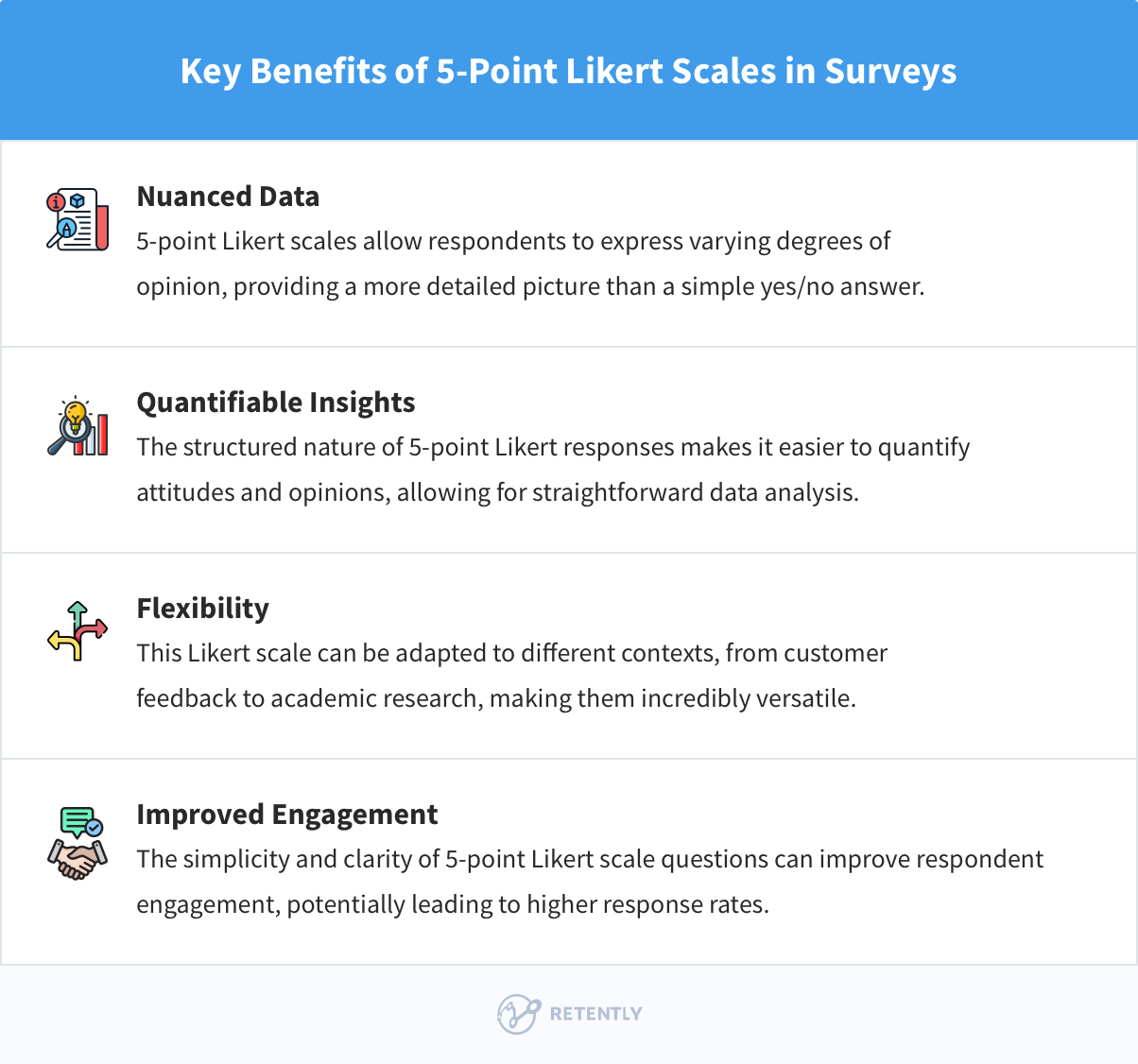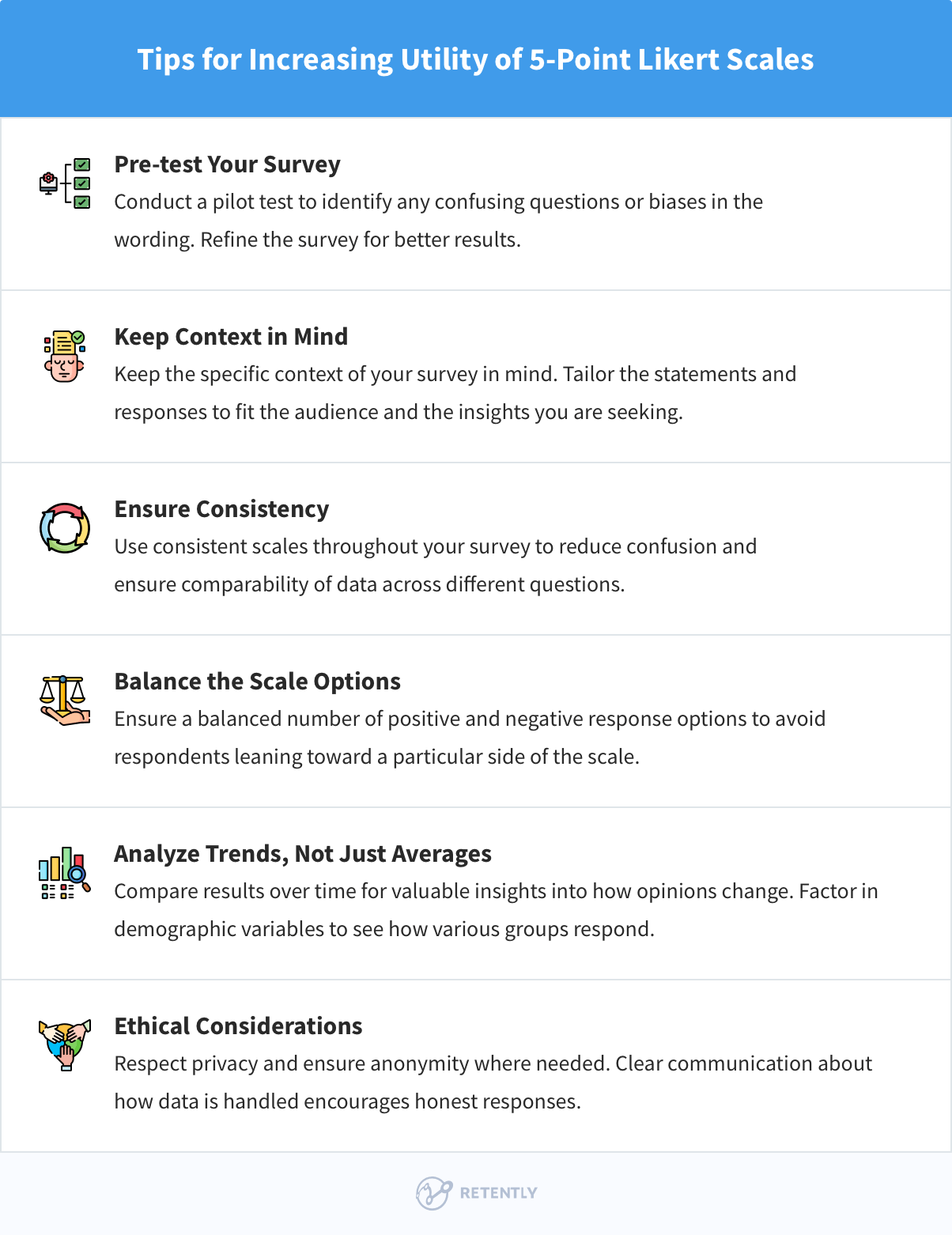Have you ever wondered how some surveys give really spot-on insights? A lot of that precision comes from how the questions are framed and the types of responses they gather. That’s where Likert scales come into play – a handy tool in the survey toolkit.
Understanding the 5 point Likert scale is crucial for anyone looking to collect accurate data on opinions and attitudes. This article will clarify its structure, explain how to create effective Likert questions, and offer insights into analyzing and interpreting the provided answers to inform your decisions.
So, ready to dive deeper into how you can use 5-point Likert scale to sharpen your survey skills? Let’s get started and turn those average surveys into precision tools for gathering insights.
Key Takeaways
- The 5 point Likert scale is a rating system that allows respondents to express a range of opinions with five response options – from strong agreement to strong disagreement, including a neutral option, enabling nuanced feedback for surveyors.
- Effective 5 point Likert scale questions require clear, unbiased phrasing, a balance of positively and negatively worded statements, and a neutral option to avoid response bias and ensure clarity.
- Using charts and graphs to visualize 5 point Likert scale data helps to interpret this ordinal data accurately. Additionally, cross-checking responses with demographic information can provide deeper insights into satisfaction levels within different groups.
Understanding the 5 Point Likert Scale
The 5 point Likert scale is a rating system that provides five possible responses to survey questions, representing a range from one extreme attitude to its opposite. It is used in surveys to measure opinions with greater nuance than a simple “yes” or “no”. The typical response options include:
- Strongly Disagree
- Disagree
- Neither Disagree Nor Agree
- Agree
- Strongly Agree
This allows respondents to convey their level of agreement with a given statement.
The Basics of 5 Point Likert Scale
The 5 point Likert scale is made up of two extreme response options, two intermediate options, and one neutral option, offering a comprehensive range of Likert scale options for survey participants to express their attitudes accurately. It is user-friendly, as they simply select the level of agreement or disagreement with a provided statement.
It’s important to note a distinction – a 5 point Likert-type scale involves individual questions answered on the scale, whereas a full-blown Likert scale assesses various subject dimensions through a series of scaled statements.
The story of Likert scales starts with Rensis Likert, who came up with this method way back in the 1930s. He realized there was a need for a better way to capture the shades of grey in people’s opinions, not just black-and-white answers. Since then, Likert scales have become a go-to method in surveys.
Measuring Attitudes with Precision
Unlike binary scales that offer two options (yes/no or true/false), the 5 point Likert scale allows a more nuanced expression of viewpoints. It lets you capture the intensity of people’s feelings about a certain topic, not just whether they lean a certain way. By providing a range of options, it captures varying degrees of opinion from:
- Strong agreement
- Agreement
- Neutral
- Disagreement
- Strong disagreement
This can give you a much clearer picture of what your audience really thinks and feels, being beneficial for sentiment analysis.
For instance, it’s one thing to know if your employees are generally happy; it’s another to understand how strong their feelings are about their work environment. This deeper insight is what makes Likert scales such a valuable tool in surveys.
Moreover, the optimal number of scale points on a Likert scale is recognized as 5 to 7, balancing the need for precision and avoiding respondent confusion while maintaining clarity between different sentiment levels.
Types of Likert Scales
While the 5-point scale is what most people think of when they hear “Likert scale”, there are actually several types to choose from, depending on what you need for your survey. Here’s a quick rundown:
- 5-point scale: This is the classic model, offering five choices from “strongly disagree” to “strongly agree”. It’s great for most general surveys and gives a clear midpoint for neutrality.
- 7-point scale: This adds two additional options, allowing for more granularity in responses. It’s useful when you think there are subtle nuances in opinion that a 5-point scale might miss.
- Even-point scales, like 4-point or 6-point: These lack a neutral middle option, which can be useful when you want to force a more definite opinion on a subject.
Key Benefits of Using a 5 Point Likert Scale in Surveys
The 5 point Likert scale offers plenty of benefits that make it a popular choice for many survey types. Its simplicity makes it easier for both surveyors and respondents to use. It provides an optimal balance by offering various response options without being too complex.
1. Flexibility
This balance makes the 5 point Likert scale versatile enough to be widely adopted across multiple industries where understanding attitudes is key. Suitable for a wide range of topics, Likert scales can be can be thus adapted to different contexts and used in almost any field, including:
- psychology
- education
- healthcare
- business
- marketing
2. Improved Engagement
The simplicity and clarity of 5-point Likert scale can improve respondent engagement. It makes them easy to understand and answer, encouraging higher response rates and more reliable data.
What’s more, respondents can express varying degrees of opinion and sentiments with the 5 point scale, which is less restrictive than binary (a simple yes/no answer) or overly complex options. As a result, it captures subtle aspects of respondents’ attitudes that will help adjust engagement approaches.
3. Nuanced Data
As already pointed out, the scale’s five response options allow expressing different degrees of satisfaction. These responses go from “strongly disagree” to “strongly agree”, including a few stops in between to capture varying degrees of agreement or disagreement. This range of options helps obtain a rich understanding of attitudes, providing a more comprehensive picture.
4. Quantifiable Insights
The straightforward format of a 5-point Likert scale improves the accuracy and reliability of data collected, offering more detailed feedback than simpler scales. Its range of options simplifies the collection of quantitative data, while its structured nature makes it easier to quantify attitudes and opinions that are straightforward to analyze and compare, enabling a deeper understanding of responses.
The scale is considered ideal for handling large sample sizes in academic research, simplifying the response process, and enhancing result evaluation.

Crafting Questions for a 5 Point Likert Scale
Crafting questions that are both clear and unbiased is the key to unlocking truly valuable insights from a 5 point Likert scale survey. Let’s dive into how you can design statements or questions and configure response options that will get you the data you’re after.
1. Considering Response Bias
Response bias is a type of survey bias that influences respondents to give a specific answer, potentially leading to unreliable data and poor business decisions. Types of response bias affecting 5 point Likert scale surveys include:
- Extreme response bias
- Social desirability bias
- Acquiescence bias
- Central tendency bias
- Halo effect bias
These biases stem from the survey’s design and the respondents’ perceptions.
Strategies to minimize response bias include:
- Using neutral wording
- Avoiding leading or loaded questions
- Addressing only one aspect of a topic at a time
- Providing a full range of response options
- Ensuring balanced response options
- Adding a “prefer not to answer” choice
But let’s go into more detail.
2. Balancing Statements for Unbiased Responses
Creating the right statements for your 5-point Likert scale is essential – they need to be crystal clear and totally unbiased. Here’s how to make sure your questions hit the mark:
- Be Clear and Concise: The questions must be phrased clearly to avoid any confusion that might affect the survey’s reliability. Each statement should be simple enough for everyone to understand it the same way. Avoid jargon or overly complex language.
- Stay Neutral: Don’t lead respondents to a particular answer. Use words that don’t carry strong emotional implications. This helps ensure that the responses you get are based on the participants’ true feelings or opinions rather than being influenced by the question’s wording. Phrases like “Don’t you think…” or “Isn’t it true that…” can bias responses. For example, instead of asking, “Don’t you think our customer service is great?” which suggests a “yes” answer, you could ask, “How would you rate our customer service?”. This type of question is more open, allowing for a range of honest responses without implying which answer is “correct” or desired.
- Focus on One Idea at a Time: Each statement should only measure one specific aspect or opinion to avoid confusion. For example, asking “How satisfied are you with the price and quality of the product?” mixes two different attributes (price and quality), which should ideally be addressed in separate questions.
- Be Specific: Vague statements can lead to ambiguous responses. The questions should be designed such that regardless of the respondent’s background or personal beliefs, the essence of the question remains clear and unbiased, allowing for objective feedback.
However, note that incorporating both positively and negatively worded statements in a survey does not necessarily cancel out response bias. In fact, respondents are more likely to disagree with negatively worded questions, which may introduce a new bias. Acquiescence bias – where respondents tend to agree with the questions irrespective of their actual opinion – can be reduced by avoiding confirmatory phrasing and providing a neutral response option.
3. Tailoring Responses for Clear Insights
Choosing the right response options is just as important as crafting the statements. The 5-point Likert scale includes a balance of two extremes and a neutral option, enabling nuanced feedback that is crucial for generating clear insights aligned with the objective of the survey. By carefully tailoring response options, survey admins can gather data that sheds light on varied degrees of sentiment, whether positive, negative, or neutral.
Here’s how to set up your response range:
- Standard Range: Typically, you’ll have options ranging from “strongly disagree” to “strongly agree”, with “neither agree nor disagree” as a middle point. This range captures the degrees of agreement or disagreement effectively.
- Extended Range: If you need more nuanced data, consider adding more gradations, such as “moderately agree” or “slightly disagree”.
Irrespective of the option you go for, always provide balanced response options. When you give respondents choices, like in multiple-choice questions, make sure the options cover a range of potential opinions or reactions. This allows everyone, regardless of their perspective, to find an answer that closely matches their views, leading to more accurate results. The response options should also match the type of information the survey aims to gather.
4. Neutral Point Considerations
While the 5-point Likert scale inherently includes a neutral point, one question often lingers when it comes to Likert scales: should you include a neutral option or not?
As a rule of thumb, a “neutral” option should be included for respondents without a strong opinion. Yet, including a neutral option can be helpful or harmful, depending on your survey goals:
- Include a Neutral Option: This is a good choice if you genuinely want to know if respondents feel neutral or unsure about a question. It can help you avoid forcing a decision when none exists, leading to more accurate data. This is a relevant option especially when the topic is sensitive.
- Omit Neutral: In cases where you need a definitive opinion or when neutrality itself can skew the data, you might choose to leave out the neutral option. A middle point can sometimes complicate interpretation. It can be particularly useful in market research to gauge strong opinions.
Therefore, choosing whether to include a neutral option can greatly influence the kind of data you collect. Including it can prevent frustration among respondents who might otherwise feel forced into choosing an option that doesn’t truly reflect their feelings. On the other hand, removing it can help you collect more decisive data, which might be necessary for certain analytical purposes.
5. Ensuring Clarity and Relevance
Clarity and specificity are essential when crafting survey questions. Each question should focus on a single aspect to avoid confusion. Moreover, all response options on the Likert scale, including mid-points, should be clearly labeled to ensure participants understand the choices available to them.
Additionally, it’s important to consider cultural sensitivities when creating survey content. Pilot testing surveys with a small sample and paying attention to the question order can enhance question clarity and improve the relevance and accuracy of survey data.
With well-crafted statements and thoughtfully configured response options, your 5-point Likert scale questions can become a powerful tool for gathering precise and meaningful data from your surveys. The key is to align your question design closely with your survey’s objectives, ensuring that each question contributes effectively to the insights you need.
Integrating 5-Point Likert Scales into Surveys
Incorporating Likert scales into your surveys isn’t just about slapping some scale questions into the mix. It’s about thoughtful integration and consideration of the respondent’s experience. Let’s explore how to do this effectively, ensuring your survey is both engaging and ethically sound.
1. Survey Layout and Structure
Here’s some best practices for integrating 5-point Likert scales to increase the effectiveness and quality of data garnered:
- Logical Flow
Organize your questions in a logical sequence that flows naturally. Start with broader questions and narrow down to more specific ones. This helps respondents warm up without feeling overwhelmed right off the bat.
- Group Similar Topics
To keep the survey coherent and easy to follow, group similar Likert scale questions together. This helps maintain the focus of your respondents and analyze the data later.
- Balance the Scale Usage
While Likert scales are valuable, using them for every question can be overwhelming. Mix in different types of questions where appropriate to keep the survey dynamic and engaging.
- Keep It Short and Sweet
Long surveys can lead to fatigue, which might compromise the quality of your data. Aim for brevity while still gathering the necessary information. Be concise in your questions and only ask what’s needed to achieve your objectives.
- Clear Instructions
Make sure each section of your survey has clear instructions on how to answer the questions. This is particularly important for 5-point Likert scale questions, where understanding the scale is essential. It helps prevent confusion and ensures that responses are accurate.
- Visual Breaks
Use visual elements like section dividers, sliders or graphical representations to break up long blocks of 5-point Likert scale questions. This helps make the process more interactive and keep the respondent’s attention focused.
2. Ethical Considerations
When conducting surveys, addressing privacy, consent, and ethical issues is a must. Ensuring that participants are well-informed and their data is protected builds trust and integrity in the research process. Let’s explore the main aspects to look into:
- Informed Consent: Before a respondent begins your survey, make sure they understand what the survey is for, how their data will be used, and who will have access to it. Clear, straightforward consent forms are a must.
- Privacy and Anonymity: Assure respondents that their responses are confidential and that identifying information is either not collected at all or is securely stored and separated from their responses. This can increase the honesty of their responses, especially on sensitive topics.
- Cultural Sensitivity: Be mindful of cultural nuances that might influence how questions are perceived. This is particularly important when surveys are distributed across different regions or demographic groups.
Implementing the 5 Point Likert Scale in Different Survey Types
The versatility of the 5 point Likert scale facilitates its use in different types of surveys, including those for:
- market research
- public opinion
- health-related behaviors
- customer experience surveys
- employee engagement surveys
In customer experience surveys, it can effectively measure customer satisfaction and perceptions of service quality. It’s also employed in employee engagement surveys to assess employee satisfaction and engagement within the organization.
In academic settings, it’s used to capture students’ or participants’ attitudes, often in research projects or educational assessments.
1. Customer Feedback Surveys
In assessing service quality, a 5-point Likert scale can detail satisfaction with specific aspects of, say, a dining experience, and generally gauge overall satisfaction by offering options from “strongly dissatisfied” to “strongly satisfied”. Feedback gleaned from customers through 1 to 5 rating surveys is critical for enhancing product quality, identifying improvement areas, and boosting overall customer satisfaction.
The scale is particularly well-suited for surveys with a singular focus, enabling straightforward analysis of customer sentiments or opinions towards specific aspects of the product or service in question.
2. Employee Engagement Surveys
The 5-point Likert scale can be used in employee engagement surveys to measure satisfaction levels with the company’s investment in various areas such as education and training. It can assess satisfaction by prompting responses on statements related to job satisfaction, including:
- Strongly disagree
- Disagree
- Neutral
- Agree
- Strongly agree
Employee engagement surveys may use a 5 point Likert scale to measure aspects such as agreement with statements about workplace policies or satisfaction with employee benefits.
3. Research and Academic Surveys
The 5 point Likert scale is extensively used in academic research to gauge attitudes and values. Likert scales designed for academic studies often include a neutral midpoint to facilitate respondent subjectivity, allowing for a clear range of agreement or disagreement.
In the context of academic surveys, the scale is adept at measuring respondents’ level of agreement with theoretical and research-based statements.
Analyzing and Interpreting 5 Point Likert Scale Data
Once you’ve gathered all your responses, the next big step is to dive into the data. Analyzing and interpreting the feedback from 5-point Likert scales, if done correctly, can provide deep insights into the attitudes and opinions of your respondents. Here’s how to handle this crucial phase.
1. Visualizing Data from a 5 Point Likert Scale
This involves transforming responses into easily interpretable formats, such as charts or graphs. Design choices in the visualization of Likert scale data, such as color coding for positive, neutral, and negative ratings, enhance the interpretability of the results.
Bar charts and pie charts are commonly used to depict the distribution of Likert scale responses, showing how many participants selected each scale point. These charts can display either actual numbers or percentages, representing the count of responses in each category.
By charting the frequency of responses, one can reveal the distribution and central tendency of the data, providing a clear picture of the overall sentiment. Here is a list of effective visualization techniques to consider:
- Bar Charts: Ideal for showing how many respondents selected each point on the scale for a particular question. This can quickly highlight trends and outliers.
- Pie Charts: Useful for illustrating the percentage breakdown of responses for each category in a single question.
- Heat Maps: Great for displaying data across several variables or questions, showing the intensity of responses through color gradients.
- Histograms: Useful for showing the frequency of each response and highlighting trends or deviations in data.
- Box Plots: These can be employed to depict the range and distribution of responses, showing medians, quartiles, and potential outliers.
Using these tools simplifies the complex data and makes your findings more accessible to those who may not have a background in data analysis.
2. Analyzing Ordinal Data
When working with 5-point Likert scale data, it’s essential to employ specific techniques for summarizing and analyzing the responses effectively. These methods ensure that the ordinal nature of the data is appropriately handled, allowing for accurate interpretations and meaningful conclusions.
Ordinal data means that responses can be ranked, but the gaps between them are not consistently equal, which can complicate analysis. For such data, nonparametric tests such as chi-square or Mann-Whitney U are often recommended for analyzing Likert data to address its ordinal nature. However, if you have a large enough sample size and the data is roughly normally distributed, parametric tests can also be appropriate for analyzing Likert scale responses. Let’s explore some of these techniques:
- Frequency Distribution: Chart how many responses fall into each category (strongly agree, agree, neutral, disagree, strongly disagree). This provides a quick snapshot of where opinions lie.
- Summarize Basic Descriptive Statistics: Calculating the mean (average) or median (middle value) can help you understand the central tendency of responses. This is particularly useful when comparing different groups or questions within the same survey. Identifying the mode (the most frequently occurring response) can also offer insights, especially in determining the most common stance among respondents.
- Cross-tabulation: Cross-tabulation is a method used to analyze the relationship between multiple variables in survey data. Look at the relationship between different questions or demographic variables. This helps understand how various groups within your sample may feel about specific issues, guiding strategic decisions and targeted interventions to improve satisfaction.
3. From Data to Decision-Making
The ultimate goal of data visualization is to transform raw data into actionable insights. By using survey platforms like Retently for visualizing 5 point Likert scale data, one can dynamically represent findings and extract actionable insights.
Many modern specialized survey software come with built-in analytics that allow you to create charts and graphs directly from your survey responses. This functionality makes it easy to visualize trends and patterns, compare different demographic groups, and identify key areas of strength and weakness in the data collected. Using these tools, you can efficiently transform your survey data into visually appealing and insightful presentations that help inform decisions and strategies.
Quick Wins
Likert scales have proven to be invaluable in surveys, providing a structured, quantifiable method for capturing a range of opinions. Let’s go through some final tips to ensure you maximize the accuracy and utility of your survey results using 5-point Likert scales:
- Pre-test Your Survey: Before rolling out your survey to a larger audience, conduct a pilot test. This will help you identify any confusing questions or biases in the wording, allowing you to refine the survey for better results.
- Keep Context in Mind: Always design your Likert scale questions with the specific context of your survey in mind. Tailor the statements and response options to fit the audience and the specific insights you are seeking.
- Ensure Consistency: Use consistent scales throughout your survey. This reduces confusion for respondents and ensures comparability of data across different questions.
- Balance the Scale Options: Make sure the number of positive and negative response options is balanced. This helps avoid response biases where respondents might lean towards a particular side of the scale.
- Analyze Trends, Not Just Averages: When using Likert scales in recurring surveys, compare the results over time. This can provide valuable insights into how opinions and attitudes change, helping you gauge the impact of any adjustments. Factor in demographic variables to understand how different groups respond.
- Ethical Considerations: Always respect privacy and ensure anonymity where needed. Clear communication about how you handle and use survey data builds trust and encourages honest responses.

By following these tips and leveraging the strengths of Likert scales, you can greatly improve the effectiveness of your surveys. If you’re looking to gauge customer satisfaction, employee engagement, or research specific topics, Likert scales provide a reliable method to measure, analyze, and act on the data you collect.
Conclusion
Likert scales are more than just a way to structure survey responses. They are a nuanced tool that can greatly improve the depth and usefulness of the data you collect. Throughout this guide, we’ve explored how the 5-point scales function, how to design them effectively, and how they can be integrated and analyzed within your surveys.
Its simplicity and ease of use make it highly versatile for different types of surveys, from customer feedback to academic research. By crafting effective questions and visualizing data accurately, it can provide valuable insights to guide decision-making.
Thoroughly analyze and effectively visualize the data from your 5-point Likert scale surveys with Retently to draw meaningful conclusions that go beyond superficial insights. Start with a free trial and remember, the goal of data analysis is not just to summarize responses, but to uncover deeper trends and relationships that inform impactful actions.





























 Greg Raileanu
Greg Raileanu 

 Alex Bitca
Alex Bitca 
 Christina Sol
Christina Sol 

